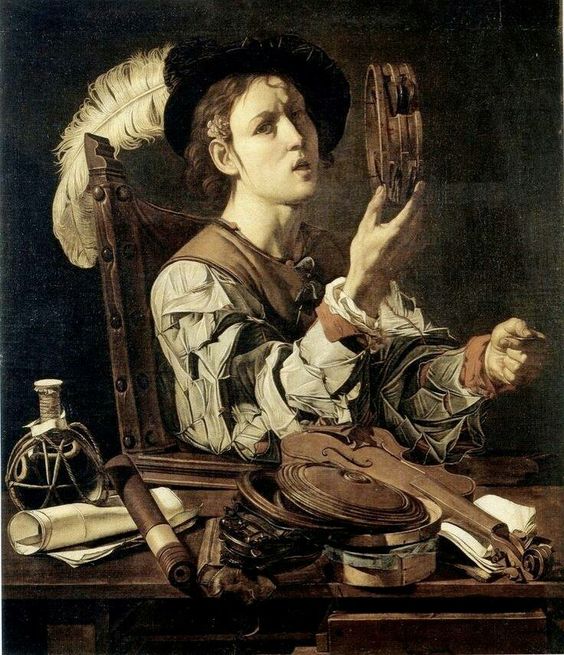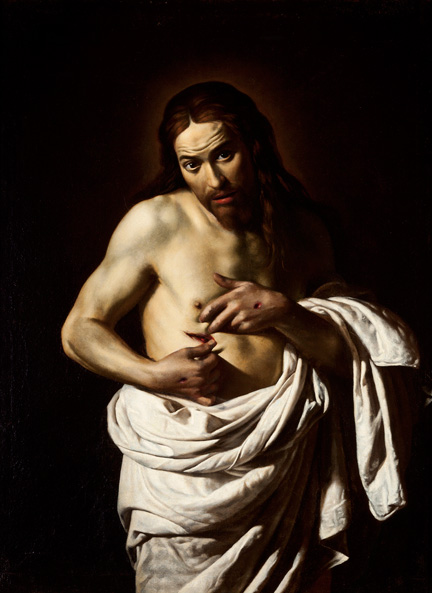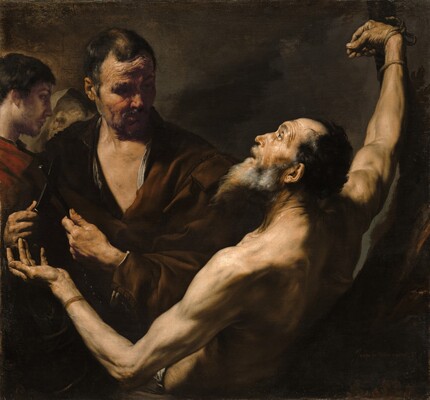The National Gallery, London 12 October
2016 – 15 January 2017
National Gallery of Ireland (11 February
– 14 May 2017)
Royal Scottish Academy (17 June – 24
September 2017)
Beyond Caravaggio is the first major
exhibition in the UK to explore the work of Caravaggio and his influence on the
art of his contemporaries and followers.
Michelangelo Merisi da Caravaggio (1571–1610) is one of the most
revolutionary figures in art. His strikingly original, emotionally charged
paintings, with their intense naturalism, dramatic lighting and powerful
storytelling, had a lasting impact on European art and the reverberations echo
down to our own time.
“The
painters then in Rome were so taken by the novelty, and the younger ones
especially flocked to him and praised him alone as the only true imitator of
nature, looking upon his works as miracles, they vied with each other in
following him.” Giovan Pietro Bellori, 1672
Caravaggio
did not have pupils or travel extensively, and he died at the relatively young
age of 39, and yet his influence was widespread and astonishingly diverse. From
1600, artists from across Europe flocked to Rome to see his work, and many went
on to imitate his naturalism and dramatic lighting effects – these included
artists as talented and varied as Orazio Gentileschi, Valentin de Boulogne, Jusepe de Ribera and Gerrit van Honthorst. Paintings by Caravaggio
and his followers were highly sought after in the decades following his death,
but fell out of favour by the middle of the 17th century.
The show offers
a unique opportunity to discover a number of hidden art treasures from around
the British Isles. The majority of the 49 paintings in the exhibition come from
museums, stately homes, castles, churches and private collections across Great
Britain and Ireland. These paintings, many of which will be unfamiliar to
visitors, will demonstrate how Caravaggio’s art came to inspire a whole
generation of painters.
'Beyond
Caravaggio' begins by exploring Caravaggio’s early years in Rome, where he
produced works depicting youths, musicians, cardsharps and fortune tellers.
These paintings were considered highly original on account of their everyday
subject matter and naturalistic lighting. The National Gallery’s own
Boy Bitten by a Lizard (1594–5)
will hang alongside works including
Cecco del Caravaggio’s 'A Musician' (about 1615, Apsley House),
Bartolomeo Manfredi’s 'Fortune Teller' (about 1615–20, Detroit Institute of Arts)
and a masterpiece by French Carvaggesque painter, Georges de la Tour, The Cheat with the Ace of Clubs (1630–34) from the Kimbell Art Museum in Dallas.
Boy Bitten by a Lizard (1594–5)
will hang alongside works including
Cecco del Caravaggio’s 'A Musician' (about 1615, Apsley House),
Bartolomeo Manfredi’s 'Fortune Teller' (about 1615–20, Detroit Institute of Arts)
and a masterpiece by French Carvaggesque painter, Georges de la Tour, The Cheat with the Ace of Clubs (1630–34) from the Kimbell Art Museum in Dallas.
The
unveiling of Caravaggio’s first public commission in 1600 caused a sensation
and quickly led to numerous commissions from distinguished patrons, among them
Ciriaco Mattei for whom Caravaggio painted
The Supper at Emmaus (1601, The National Gallery, London)

and the recently rediscovered 'The Taking of Christ' (1602, on indefinite loan to the National Gallery of Ireland from the Jesuit Community, Leeson St, Dublin).
These two paintings will be reunited with other Caravaggesque works formerly in the Mattei collection:
Giovanni Serodine’s 'Tribute Money' (Scottish National Gallery)
and Antiveduto Gramatica’s 'Christ among the Doctors' (about 1613, Scottish National Gallery, Edinburgh (on long-term loan from the Archdiocese of St Andrews and Edinburgh, from St Bride’s, Cowdenbeath).
The Supper at Emmaus (1601, The National Gallery, London)

and the recently rediscovered 'The Taking of Christ' (1602, on indefinite loan to the National Gallery of Ireland from the Jesuit Community, Leeson St, Dublin).
These two paintings will be reunited with other Caravaggesque works formerly in the Mattei collection:
Giovanni Serodine’s 'Tribute Money' (Scottish National Gallery)
and Antiveduto Gramatica’s 'Christ among the Doctors' (about 1613, Scottish National Gallery, Edinburgh (on long-term loan from the Archdiocese of St Andrews and Edinburgh, from St Bride’s, Cowdenbeath).
Caravaggio’s
practice of painting from life and his use of chiaroscuro (strongly contrasted lighting
effects) were quickly emulated, but artists did not simply replicate his style;
taking Caravaggio’s works as their starting point, they
responded to different aspects of his art and developed their own individual
approaches.
Giovanni Baglione’s 'Ecstasy of Saint Francis' (1601, The Art
Institute of Chicago) is the first truly Caravaggesque painting by another
artist.
Orazio Gentileschi, who was a friend of Caravaggio’s, is represented by two very different works.
His immensely talented daughter, Artemisia, is present in the exhibition with 'Susannah and the Elders' (1622, The Burghley House Collection).
'Christ displaying his Wounds' (about 1625-35, Perth Museum and Art Gallery) by Giovanni Antonio Galli (called Lo Spadarino) is one of the most striking and memorable paintings in the show.
Orazio Gentileschi, who was a friend of Caravaggio’s, is represented by two very different works.
His immensely talented daughter, Artemisia, is present in the exhibition with 'Susannah and the Elders' (1622, The Burghley House Collection).
'Christ displaying his Wounds' (about 1625-35, Perth Museum and Art Gallery) by Giovanni Antonio Galli (called Lo Spadarino) is one of the most striking and memorable paintings in the show.
Caravaggio
traveled twice to Naples – both times whilst on the run (the first after
committing murder). The Kingdom of Naples was then part of the Spanish Empire
and home to many Spanish artists, like
Jusepe de Ribera who is represented by three works, (notably 'The Martyrdom of Saint Bartholomew', 1634, National Gallery of Art, Washington).
Neapolitan artists also frequently travelled to Rome where they had the opportunity to see Caravaggio’s earlier works: this was the case with
Mattia Preti, whose 'Draughts Players' (about 1635, Ashmolean Museum of Art, Oxford) will be on display.
Jusepe de Ribera who is represented by three works, (notably 'The Martyrdom of Saint Bartholomew', 1634, National Gallery of Art, Washington).
Neapolitan artists also frequently travelled to Rome where they had the opportunity to see Caravaggio’s earlier works: this was the case with
Mattia Preti, whose 'Draughts Players' (about 1635, Ashmolean Museum of Art, Oxford) will be on display.
Caravaggio’s
greatest legacy was the enduring power of his storytelling. He injected new
life into biblical stories, often blurring the lines between sacred and profane
subjects, such as in 'Saint John the Baptist in the Wilderness' (1603–4,
The Nelson-Atkins Museum of Art, Kansas City).
This will be shown alongside masterpieces by his followers, such as Nicolas Régnier’s 'Saint Sebastian tended by the Holy Irene and her Servant' (about 1626–30, Ferens Art Gallery, Hull - generously lent during Hull’s UK 2017 City of Culture celebrations)
and Gerrit van Honthorst’s 'Christ before the High Priest' (about 1617, The National Gallery, London).
This will be shown alongside masterpieces by his followers, such as Nicolas Régnier’s 'Saint Sebastian tended by the Holy Irene and her Servant' (about 1626–30, Ferens Art Gallery, Hull - generously lent during Hull’s UK 2017 City of Culture celebrations)
and Gerrit van Honthorst’s 'Christ before the High Priest' (about 1617, The National Gallery, London).
Seduced by
the power of Caravaggio’s paintings, artists continued to emulate him well
after his death, but by the middle of the 17th century Caravaggio’s
naturalistic approach had been rejected in favour of a more classicising
painting tradition. It would take almost three hundred years for Caravaggio’s
reputation to be restored and for his artistic accomplishments to be fully
recognised. Today he is rightly admired once again for his unforgettable
imagery, inventiveness and astonishing modernity.
An absolutely wonderful, must read article related to this exhibition:







,_Artemisia_Gentileschi.jpg)





_-_WGA11651.jpg)